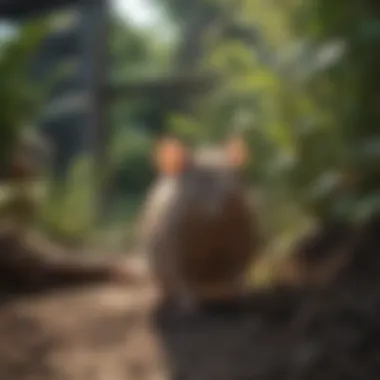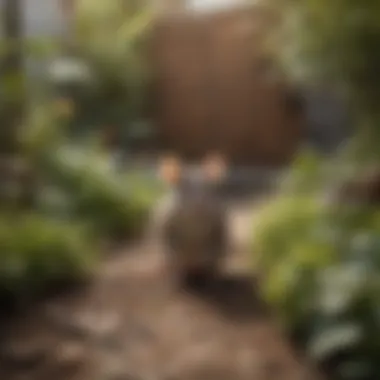Non-Toxic Ways to Get Rid of Rats in Your Yard


Intro
Rats are more than just an unsightly nuisance; they can pose health risks and cause damage to property. Homeowners often feel frustrated when confronting these pesky rodents. However, eliminating rats does not have to involve toxic poisons that could harm the environment or other wildlife. Instead, there are effective and safe methods to manage rat populations in your yard. This article explores sustainable practices for controlling rats by understanding their behavior, using natural deterrents, and implementing exclusion techniques. By reshaping your approach, you can create a safer and healthier outdoor sanctuary.
Understanding Rat Behavior
To effectively control rats, one must first grasp their behaviors and habits. Rats are social and intelligent creatures, usually nesting in groups. Understanding their habitat choices can lead to better management strategy. They often seek food, shelter, and water, so examining your yard for potential attractants is crucial.
- Shelter: Rats tend to nest in hidden spots, such as tall grasses, wood piles, and garbage heaps.
- Feeding Sources: They are opportunistic feeders, consuming a wide range of foods, including pet food, birdseed, and compost.
- Water Access: Even minor water sources, like bird baths or leaky garden hoses, can draw rats to your yard.
By removing these enticements, one can significantly reduce the likelihood of rat infestation.
Environmentally-Friendly Deterrents
After addressing potential attractants, homeowners should invest in safe deterrents. Several natural repellent options exist, proven to be effective against rats.
- Peppermint Oil: The strong scent of peppermint oil is offensive to rats. Placing cotton balls soaked in peppermint oil in suspected nesting areas may deter them.
- Ultrasonic Repellents: These devices emit high-frequency sounds to disturb rodents without harming them.
- Predatory Scents: Using scents from natural predators, like cats or foxes, can discourage rats from entering the yard.
Employing a combination of these deterrents can make your yard less inviting for rats.
Effective Exclusion Techniques
Exclusion is a vital aspect of rat management. Blocking entry points into your yard is essential to prevent future infestations.
- Seal Entry Points: Inspect fences, walls, and any openings in structures. Use materials like steel wool and caulk to close gaps.
- Maintain Cleanliness: Regularly dispose of yard waste, fallen fruits, and debris. Keeping the area clean reduces food sources for rats.
- Proper Waste Management: Secure garbage bins with tight-fitting lids. Never leave food scraps exposed in outdoor spaces.
Ongoing Maintenance Practices
Once the initial measures are taken, continuous monitoring is necessary. Here are some routine practices:
- Routine Inspections: Regularly check your yard for signs of new infestations or structural damage.
- Maintain Deterrents: Reapply natural deterrents every couple of weeks for sustained effectiveness.
- Community Awareness: Collaborate with neighbors to keep the entire area free from rat attractants.
By fostering a community approach, entire neighborhoods can become less appealing to rats.
"Prevention is always better than a cure. Regular maintenance and careful observation are key to keeping your yard rat-free."
The End
Managing a rat problem does not necessitate toxic chemicals. Understanding rat behavior, employing natural deterrents, and effectively preventing entry creates a sustainable environment. Homeowners can feel secure in their outdoor spaces for themselves, their pets, and local wildlife. With these comprehensive strategies, a rat-free yard is an achievable goal.
Foreword
Rats can pose a serious problem for homeowners, especially when they take up residence in yards. Understanding how to eliminate rats without using poisons is essential for creating a safe outdoor environment. This article not only outlines various strategies for managing rat populations but also emphasizes the importance of environmentally-friendly methods.
One of the key elements in addressing rodent issues is recognizing that poison can have unintended consequences. It may not only harm the targeted pests, but also affect other wildlife, pets, and even children. Hence, homeowners need to explore alternate ways that are effective yet safe.
By knowing rat behavior, creating barriers, and using natural deterrents, it is possible to control and reduce rat populations. This approach offers numerous benefits, such as protecting the ecosystem and enhancing the enjoyment of outdoor spaces. Homeowners will find a wealth of practical tips provided throughout this article to help them achieve a more peaceful yard.
In summary, diving into rat management without toxic solutions reflects a commitment to safety and sustainability. With the right knowledge and techniques, anyone can reclaim their yard from unwanted rodent guests.
Understanding Rat Behavior
To effectively eliminate rats from your yard, it is crucial to understand rat behavior. Knowledge of their habits, preferences, and reproductive tendencies can lead to more successful management strategies. Unlike other pests, rats exhibit strong adaptability. They can thrive in various environments, making it imperative for homeowners to identify and eliminate factors that attract these rodents.
Rats are intelligent creatures with keen survival instincts. They are both nocturnal and social, often living in groups. Understanding their daily rhythms helps in setting up effective traps and deterrents. Factors such as their habitat preferences, diet, and reproduction patterns play significant roles in their behavior and interaction with the environment.
Habitat Preferences
Rats prefer environments that provide shelter, food, and water. They tend to inhabit areas close to human dwellings. Structures like sheds, storage spaces, and dense vegetation are especially appealing to them. In addition, rats are good climbers and can enter homes through small openings. This means that any clutter or organic materials in the yard can enhance their living conditions. Hence, maintaining a clean yard is essential to reduce available habitats.
Diet and Feeding Habits


These rodents are omnivorous. They often forage for a variety of foods, including grains, fruits, and leftovers from bins. Their opportunistic feeding habits mean that if food sources are abundant, they will settle in an area. Thus, it is essential to manage waste effectively and keep food storage areas secure. Noticing signs of their feeding habits, such as gnawed materials or disturbed trash, can be indicators that a rat problem exists. It also emphasizes the need for vigilant monitoring of food sources to deter them from invading.
Reproductive Patterns
Rats reproduce quickly, which can escalate an infestation. A female rat can have multiple litters each year, with each litter consisting of up to a dozen young. This rapid population growth means that even a few rats can turn into a significant problem if not addressed promptly. Understanding this aspect of rat behavior not only highlights the urgency in taking action but also emphasizes the importance of persistent prevention measures.
In summary, understanding rat behavior – encompassing their habitat preferences, dietary needs, and reproductive patterns – is crucial for effective control. This knowledge empowers homeowners to take targeted actions to create an unpleasant environment for these pests, thus reducing their presence without resorting to harmful poisons.
Identifying Signs of Infestation
Identifying signs of rat infestation is an important first step when managing a pest problem. Without recognizing the early indicators, the situation can quickly escalate. Homeowners must be vigilant and informed about the signs that rats leave behind. Detecting an infestation early can save time and resources. It allows for timely intervention before populations grow too large. Understanding the signs also helps in planning appropriate mitigation strategies.
Physical Evidence
Droppings
Droppings are one of the most common signs of rat activity. They are typically dark, pellet-shaped, and measure about quarter-inch to half-inch in length. Understanding droppings helps in identifying the presence of rats rather than other pests. Identifying droppings can point towards active areas where rats frequent. Additionally, the freshness of droppings can indicate the level of infestation. Fresh droppings are usually dark and moist, suggesting recent activity. In contrast, older droppings are dry and turn lighter or crumble.
Nests
Nests are another critical sign when identifying rat presence. They often consist of shredded materials like paper, fabric, or insulation. Nests can be found in hidden areas such as attics, basements, or under furniture. Recognizing nests is beneficial because it indicates where rats may be living and breeding. A nest's structure can vary depending on the species and available materials. Often, nests are built in areas secluded from human activity. Finding nests can help homeowners determine the extent of an infestation.
Burrows
Burrows are tunnels that rats create underground. They serve as shelters and entry points for rat activity. Identifying burrows is important since they signal a more established presence in the yard. Burrows usually have a distinct opening and may be surrounded by loose dirt or droppings. They indicate where rats are nesting and feeding. Knowing the location of burrows can aid in targeting removal efforts effectively. Homeowners need to pay attention to any disturbances in the soil or nearby vegetation.
Sounds and Disturbances
Sounds and disturbances can also provide clues about rat infestation. Rats are nocturnal creatures, and they often make noises during the night. Common sounds may include scratching or squeaking. Sometimes, these sounds can be heard in walls, ceilings, or attics. Homeowners should be aware of unusual noises during quiet hours. Disturbances, such as knocked-over items or gnaw marks on wood or wires, can also suggest their presence. Noticing these signs can prompt faster action to address potential infestations.
Creating a Less Attractive Environment
Creating an uninviting environment for rats is a key aspect of managing their presence in your yard. When rats find a space that does not meet their needs for food, shelter, and security, they are less likely to stay. A well-maintained yard can drastically reduce the chances of an infestation. It is imperative to understand that this approach does not only solve the immediate problem but also helps in preventing future issues.
Proper Waste Management
Proper waste management is crucial in keeping rats away. Rats are opportunistic feeders and will scavenge through trash to find food. To eliminate this food source, homeowners should ensure that garbage bins are sealed and cleaned regularly. Use bins that have tight-fitting lids to prevent access. Additionally, placing trash in a contained area away from the house diminishes the likelihood of attracting these pests. Having a consistent waste management schedule is also beneficial in minimizing odors that can lure rats into the vicinity.
Eliminating Food Sources
Beyond waste, it is important to restrict all possible food sources that attract rats. This includes pet food left outside, bird seed spills, or dropped fruits from trees. Homeowners should promptly clean up any food remnants in the yard. Storing pet food indoors and using rodent-proof containers for birdseed can also be effective strategies. Being vigilant about food availability will contribute significantly to a less appealing environment for these animals.
Managing Landscaping
Trimming Bushes
Trimming bushes is a significant method for creating less appealing living conditions for rats. Overgrown shrubs can offer shelter and concealment for these pests. By regularly pruning shrubs, homeowners can reduce hiding spots. This direct action not only makes the space less hospitable but also enhances visibility in the yard. Well-trimmed bushes serve as a visible deterrent, making it easier to spot any potential infestation signs early.
Removing Debris
Removing debris from your yard is also a vital practice. Accumulated debris, such as piles of leaves, wood, or unused garden materials, provides ideal nesting sites for rats. Keeping the yard tidy by removing clutter helps to eliminate these potential habitats. A clean yard can significantly decrease the likelihood of attracting rats. Regular cleaning routines should include checking corners, under decks, and near fences where debris might accumulate. Taking these steps can invariably assist in maintaining a rat-free environment.
Natural Deterrents
Natural deterrents play a crucial role in managing rat populations without resorting to toxic solutions. By utilizing environmentally-friendly methods, homeowners can create an unwelcoming environment for these rodents. This section will delve into specific natural deterrents, their effectiveness, and considerations for their use.
Essential Oils
Essential oils are derived from plants and are known for their strong scents, which can repel rats effectively. Oils such as peppermint, eucalyptus, and citronella have been recognized for their unpleasant aroma to rodents.
- Application: Homeowners can dilute these oils in water and spray them in areas where rat activity is likely. This includes entry points, nests, and places where feed is stored.
- Benefits: Using essential oils offers a dual advantage. It not only deters rats but also provides a pleasant smell for human occupants. Moreover, they are safer for pets and children compared to chemical repellents.
- Considerations: It is important to reapply essential oils regularly, especially after rainfall or heavy winds which may disperse the scent.


Homemade Sprays
Creating homemade sprays using natural ingredients can enhance your efforts in keeping rats at bay. A mixture that combines water, vinegar, and spices can be quite effective. For instance, a spray made with cayenne pepper or garlic can deter rodents if applied frequently.
- Recipe: A simple recipe includes mixing one cup of water, half a cup of vinegar, and one tablespoon of cayenne pepper. Shake well and keep the solution in a spray bottle.
- Application: Spray this solution around the yard, focusing on key areas like around gardens, garbage bins, and near cracks in walls.
- Benefits: One significant benefit is that these sprays are easy to make and apply. They also remain relatively inexpensive compared to commercial products. Plus, they do not introduce harmful chemicals into the ecosystem.
Using Plants as Repellents
Incorporating specific plants into your landscape can serve as a natural deterrent for rats. Some plants emit odors that rodents find unappealing, thus encouraging them to leave the area.
- Effective Plants: Some of the most common plants that repel rats include:
- Placement: Planting these species around gardens or near entry points can provide a natural barrier.
- Benefits: Besides their repellent properties, these plants can also enhance the aesthetic appeal of a yard. They require minimal maintenance and can thrive in various climates.
- Mint: Known for its strong aroma.
- Rhubarb: Its leaves contain compounds that deter pests.
- Lavender: Pleasant for humans but disliked by rodents.
Utilizing natural methods not only minimizes health risks but also promotes a balanced ecosystem. With careful application and regular monitoring, homeowners can effectively keep rat populations under control without resorting to toxins.
Physical Barriers
Physical barriers play a crucial role in preventing rats from invading your yard. These methods provide a non-toxic way to secure your space and deter rodents effectively. Implementing physical barriers goes beyond temporary fixes; it creates a long-lasting shield against future infestations. Homeowners can gain peace of mind knowing they have invested in protective measures that not only keep rats at bay but also enhance the overall aesthetics of their outdoor spaces.
Fencing Options
Wire Fences
Wire fences serve as a physical deterrent for rats trying to enter your yard. One key characteristic of wire fences is their strength and durability. When installed properly, wire fences act as an impenetrable barrier, minimizing the risk of rats burrowing under or squeezing through. This kind of fencing is often favored due to its versatility. It comes in various heights and gauges, allowing for customization based on your specific needs.
A unique feature of wire fences is their visibility, enabling homeowners to monitor if any attempts are made by rodents to infiltrate their space. However, some disadvantages include the potential for rusting over time, particularly if not treated with a protective coating. Additionally, if installed incorrectly, gaps can develop, negating its effectiveness.
Underground Barriers
Underground barriers provide another layer of protection against rat invasions. This method involves burying materials such as hardware cloth or concrete to create a robust barrier several inches below the ground surface. The key characteristic of underground barriers is their ability to prevent rats from digging underneath existing structures or fences.
These barriers are popular because they provide a nearly foolproof method of establishment that rats find challenging to breach. A unique aspect of underground barriers is their longevity and effectiveness. Unlike some surface barriers, they do not easily succumb to environmental elements. However, installation can be labor-intensive and may require expertise to ensure proper depth and coverage.
Sealing Entry Points
Sealing entry points is another critical element in preventing rats from making your yard their home. Inspect your property for cracks, holes, or gaps in fences, walls, and foundations. Common entry points include the spaces around utility lines and vents. Once identified, these areas should be filled using suitable materials like steel wool, caulk, or metal flashing. This practice improves the overall integrity of your home while contributing to rat prevention efforts.
Trapping Methods
Trapping methods are a critical part of managing rat populations in your yard without resorting to toxic substances. By using traps, you can eliminate rats humanely and effectively while minimizing risks to other wildlife and pets. This approach allows for immediate intervention and can be tailored to fit the specific circumstances of your yard. Traps are particularly valuable because they provide real-time results, often leading to quicker reductions in rat numbers compared to other methods. However, it is crucial to understand how to choose and set traps correctly to achieve optimal results.
Types of Traps
Snap Traps
Snap traps are simple devices designed to kill rats quickly. They work by using a spring-loaded mechanism that snaps shut when triggered. This design is practical and very effective for homeowners looking for efficient ways to manage their rat issues. The key characteristic of snap traps is their instant action, which can provide a decisive solution. They are generally more affordable than many other options, making them a popular choice.
One unique feature of snap traps is their ease of use. Setting the trap involves a straightforward, mechanical process, and they require minimal maintenance once in place. However, there are some disadvantages to consider, such as the possible injury risk to pets or non-target animals. Homeowners must position snap traps carefully to prevent accidental triggering by unintended targets. In summary,
- Advantages:
- Disadvantages:
- Quick and lethal
- Cost-effective
- Easy to set up
- Risk to pets
- Requires careful placement
Live Traps
Live traps offer an alternative for those wary of killing wildlife. These traps capture rats alive, allowing you to relocate them away from your property. The key characteristic of live traps is their humane approach, which is appealing for homeowners with concerns about animal welfare. Depending on local laws, some jurisdictions may require you to use this method when dealing with pest problems.
The unique feature of live traps is the ability to monitor and relocate. After capturing a rat, you can choose to release it responsibly in a suitable area, ideally several miles away. However, this method also presents challenges. It necessitates regular checking of the traps to ensure captured animals do not suffer from stress or starvation. Additionally, relocating rats can cause them to establish a new nest in a different area, potentially spreading the problem.


- Advantages:
- Disadvantages:
- Humane option
- Monitor captured animals
- Require regular checking
- Potential for relocation complications
How to Set Traps Effectively
Setting traps effectively requires attention to detail and an understanding of rat behavior. Here are key steps to setting traps:
- Identify high-traffic areas by observing signs of rat activity, such as droppings or gnaw marks.
- Position traps perpendicular to walls or runways where rats move. This increases the likelihood of a capture.
- Secure bait. Rats are attracted to various baits, such as peanut butter or dried fruit, so use what you have available.
- Check traps regularly, ideally every day, to ensure humane treatment and to prevent stress on captured animals.
By following these steps and understanding the nuances of different traps, homeowners can manage rat populations while minimizing the impact on the environment and maintaining their yard's integrity.
Professional Help
Engaging a professional service to manage rat infestations can often be the most effective route for homeowners. While many prefer to address the issue personally, rats can pose health risks and complicate living conditions. Professionals bring expertise, specialized tools, and knowledge of local regulations that may not be accessible to the average homeowner. They understand rat behavior deeply and can identify hidden nest locations that may not be visible. Moreover, they can assist with comprehensive inspections that ensure all problem areas are addressed.
Choosing to call an exterminator is an important decision. It is vital to understand the signs and situations that warrant this action. Not every case requires professional intervention, but certain conditions might make it necessary to seek help.
When to Call an Exterminator
Determining when it is appropriate to involve an exterminator can be nuanced. Here are some critical factors:
- Extent of Infestation: If you see multiple signs of rat presence, such as droppings, nests, or burrows, it might indicate a severe infestation. A professional can help assess the scope of the problem.
- Health Risks: Rats can carry diseases that pose serious health risks. If there are indications that health threats are rising, professional intervention is advisable.
- Ineffective DIY Methods: If your attempts to remove rats using traps or natural deterrents have not yielded results, it may be time to consult a professional.
- Safety Concerns: Handling traps, especially in close quarters, may involve risks. Professionals have training to manage this safely.
In general, if you cannot manage the situation effectively on your own, reaching out to an exterminator is wise. They can provide tailored solutions based on their findings.
Evaluating Service Providers
Selecting the right exterminator involves some considerations. Not all service providers offer the same quality of service. Here’s how you can efficiently evaluate potential professionals:
- Qualifications: Check that the exterminator is licensed and certified. This ensures they comply with local laws and guidelines.
- Reputation: Look for reviews or testimonials from previous clients. Consistent positive feedback is a good indicator of reliable service.
- Methods Used: Ensure the selected company utilizes humane and non-toxic methods, especially relevant for those interested in eco-friendly practices.
- Experience: Longevity in the field can indicate an understanding of different situations and potential techniques for managing infestations.
- Consultation: A reputable company should offer a thorough consultation before commencing work, where you can ask questions and discuss concerns.
Long-Term Prevention Strategies
Long-term prevention strategies are essential for maintaining a rat-free yard. Without consistent effort, rats can re-infilttrate any environment where they find the right conditions. The significance of taking preventive measures lies in reducing the odds of future infestations and promoting an overall healthier outdoor space. Homeowners benefit in several ways when they adopt these strategies.
First, creating barriers and managing resources can deter rats from entering your yard. By controlling the environment, it becomes less inviting for these pests. Additionally, proactive steps taken now can save homeowners from more extensive and costly measures later. Developing a routine for upkeep ensures that any changes within the yard are monitored, which can prevent unnoticed nesting and feeding sites.
Moreover, investing in sustainable practices contributes positively to the broader ecosystem. It is not just about keeping rats away; promoting biodiversity and balanced environments creates a more harmonious outdoor experience. Long-term solutions focus on creating a synergy between human activity and nature, helping conditions that can be favorable for rats to be minimized.
Regular Maintenance Checks
Regular maintenance checks form the foundation of effective long-term prevention strategies. Periodically inspecting the yard for signs of rat activity can lead to early detection of potential problems. Homeowners should look for visual clues, such as droppings or signs of gnawing, that could indicate an existing problem. By regularly maintaining garden spaces, homeowners can address any issues before they escalate.
Establish a schedule for maintenance checks. Depending on your specific environment, checking every few weeks can be effective, especially during warmer months when rats are more active. During these checks, assess potential entry points where rats could gain access. You might also want to evaluate areas where food or shelter might be abundant, such as stacks of wood or dense vegetation.
Adopting Sustainable Practices
Adopting sustainable practices not only aids in rat prevention but also promotes environmental health. A holistic approach to yard management includes selecting environmentally-friendly products for maintenance and choosing native plants that naturally deter pests. For example, incorporating plants like mint or lavender can help repel rats due to their strong scents.
Moreover, minimizing waste and recycling organic materials can significantly reduce the attraction for rats. Composting is beneficial, but it requires proper management to ensure it does not become a food source for pests. Encloses compost bins with tight lids and place them away from living spaces to reduce risks.
Consider also using mulch made from naturally-derived materials. This not only supports the plants but can also deter rat activity in the area.
Ultimately, these sustainable practices create a resilient ecosystem that can withstand changes and reduce the need for intervention in the future.
Closure
In this article, we explored a comprehensive range of methods to manage and eliminate rat populations in your yard without resorting to poisons. The importance of using non-toxic solutions cannot be overstated. By avoiding poisons, you not only protect the environment but also safeguard pets and local wildlife that can unintentionally come into contact with harmful substances.
Key elements discussed include understanding rat behavior, which is crucial for effective control. Recognizing their habits helps in devising targeted strategies that address the root causes of infestations. Proper waste management and landscape maintenance are essential practices that deter rats from establishing habitats in your yard.
Natural deterrents, trapping methods, and establishing physical barriers demonstrate that there are numerous strategies available. Each method has its own merits and can be tailored to suit individual circumstances. The article emphasizes that homeowners should also consider long-term prevention strategies, which include regular maintenance and sustainable practices.
By synthesizing these insights, you gain a holistic view that empowers you to manage rat issues responsibly. Homeowners are encouraged to take action proactively, implementing these methods to create a safer outdoor environment. The focus on sustainable and practical solutions ensures you can maintain your property effectively while being mindful of ecological dynamics and the well-being of all creatures involved.















